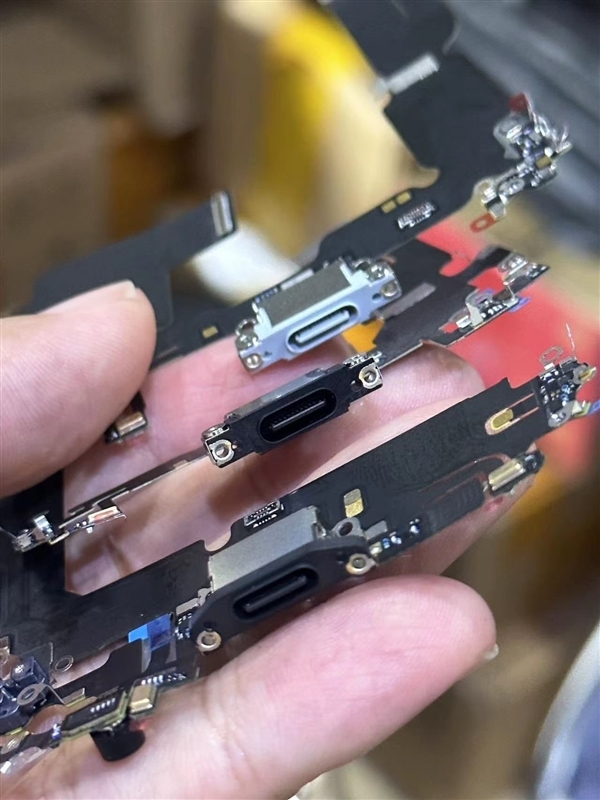 Technology peripherals
Technology peripherals
 It Industry
It Industry
 iPhone 15 introduces new USB-C interface: extremely fast charging and fast data transfer
iPhone 15 introduces new USB-C interface: extremely fast charging and fast data transfer
iPhone 15 introduces new USB-C interface: extremely fast charging and fast data transfer
According to multiple sources and component leaks, iPhone 15 will be launched on August 18. This phone will use a new USB-C interface and bring a number of upgrades
According to the editor’s understanding, the next generation iPhone 15 series will fully adopt the USB-C interface, which means that users will no longer Use Lightning interface for charging and data transfer. According to the latest report from 9to5Mac, through the upgrade of the USB-C interface, the iPhone 15 series will have faster charging speeds and support up to 35W wired fast charging. Although this feature is expected to be a unique specification of the Pro version of the phone, the standard version may be limited to a maximum charging power of 27W

The two versions will also have different interface transfer rates. There is a difference. The standard version of iPhone 15 will use the USB 2.0 version, with a maximum transfer rate of 480Mbps, which is equivalent to the previous Lightning interface. The Pro version will use USB 3.2, and the transfer rate will soar to 20Gbps, which is more than 20 times faster than the standard version. There is currently no definite conclusion as to whether the USB-C interface will be encrypted. Although there are reports that there is a special chip at the end of the interface, some opinions believe that this may only be a chip added to enhance security and will not limit the power of third-party chargers
 However, considering the revenue Apple has earned through Made for iPhone (MFI) certification every year in the past, it is possible that they will implement encryption on the new USB-C interface to continue to benefit from certification fees. In addition, in order to comply with EU charging cable standards, third-party charging cables may not completely fail, but may be subject to power restrictions and can only be used in emergencies. The maximum power limit is 5V1A
However, considering the revenue Apple has earned through Made for iPhone (MFI) certification every year in the past, it is possible that they will implement encryption on the new USB-C interface to continue to benefit from certification fees. In addition, in order to comply with EU charging cable standards, third-party charging cables may not completely fail, but may be subject to power restrictions and can only be used in emergencies. The maximum power limit is 5V1A
The above is the detailed content of iPhone 15 introduces new USB-C interface: extremely fast charging and fast data transfer. For more information, please follow other related articles on the PHP Chinese website!

Hot AI Tools

Undresser.AI Undress
AI-powered app for creating realistic nude photos

AI Clothes Remover
Online AI tool for removing clothes from photos.

Undress AI Tool
Undress images for free

Clothoff.io
AI clothes remover

AI Hentai Generator
Generate AI Hentai for free.

Hot Article

Hot Tools

Notepad++7.3.1
Easy-to-use and free code editor

SublimeText3 Chinese version
Chinese version, very easy to use

Zend Studio 13.0.1
Powerful PHP integrated development environment

Dreamweaver CS6
Visual web development tools

SublimeText3 Mac version
God-level code editing software (SublimeText3)

Hot Topics
 1378
1378
 52
52
 deepseek ios version download and installation tutorial
Feb 19, 2025 pm 04:00 PM
deepseek ios version download and installation tutorial
Feb 19, 2025 pm 04:00 PM
DeepSeek Smart AI Tool Download and Installation Guide (Apple Users) DeepSeek is a powerful AI tool. This article will guide Apple users how to download and install it. 1. Download and install steps: Open the AppStore app store and enter "DeepSeek" in the search bar. Carefully check the application name and developer information to ensure the correct version is downloaded. Click the "Get" button on the application details page. The first download may require AppleID password verification. After the download is completed, you can open it directly. 2. Registration process: Find the login/registration portal in the DeepSeek application. It is recommended to register with a mobile phone number. Enter your mobile phone number and receive the verification code. Check the user agreement,
 Why can't the Bybit exchange link be directly downloaded and installed?
Feb 21, 2025 pm 10:57 PM
Why can't the Bybit exchange link be directly downloaded and installed?
Feb 21, 2025 pm 10:57 PM
Why can’t the Bybit exchange link be directly downloaded and installed? Bybit is a cryptocurrency exchange that provides trading services to users. The exchange's mobile apps cannot be downloaded directly through AppStore or GooglePlay for the following reasons: 1. App Store policy restricts Apple and Google from having strict requirements on the types of applications allowed in the app store. Cryptocurrency exchange applications often do not meet these requirements because they involve financial services and require specific regulations and security standards. 2. Laws and regulations Compliance In many countries, activities related to cryptocurrency transactions are regulated or restricted. To comply with these regulations, Bybit Application can only be used through official websites or other authorized channels
 Sesame Open Door Trading Platform Download Mobile Version Gateio Trading Platform Download Address
Feb 28, 2025 am 10:51 AM
Sesame Open Door Trading Platform Download Mobile Version Gateio Trading Platform Download Address
Feb 28, 2025 am 10:51 AM
It is crucial to choose a formal channel to download the app and ensure the safety of your account.
 gate.io sesame door download Chinese tutorial
Feb 28, 2025 am 10:54 AM
gate.io sesame door download Chinese tutorial
Feb 28, 2025 am 10:54 AM
This article will guide you in detail how to access the official website of Gate.io, switch Chinese language, register or log in to your account, as well as optional mobile app download and use procedures, helping you easily get started with the Gate.io exchange. For more tutorials on using Gate.io in Chinese, please continue reading.
 How to find the download link of Ouyi okx Android and Apple
Feb 21, 2025 pm 05:39 PM
How to find the download link of Ouyi okx Android and Apple
Feb 21, 2025 pm 05:39 PM
Ouyi OKX is a world-leading cryptocurrency exchange that provides users with a safe and convenient trading experience. Users can download Ouyi OKX's mobile apps, including Android and Apple versions through official channels.
 How to install and register an app for buying virtual coins?
Feb 21, 2025 pm 06:00 PM
How to install and register an app for buying virtual coins?
Feb 21, 2025 pm 06:00 PM
Abstract: This article aims to guide users on how to install and register a virtual currency trading application on Apple devices. Apple has strict regulations on virtual currency applications, so users need to take special steps to complete the installation process. This article will elaborate on the steps required, including downloading the application, creating an account, and verifying your identity. Following this article's guide, users can easily set up a virtual currency trading app on their Apple devices and start trading.
 Sesame Open Door Exchange App Official Download Sesame Open Door Exchange Official Download
Mar 04, 2025 pm 11:54 PM
Sesame Open Door Exchange App Official Download Sesame Open Door Exchange Official Download
Mar 04, 2025 pm 11:54 PM
The official download steps of the Sesame Open Exchange app cover the Android and iOS system download process, as well as common problems solutions, helping you download safely and quickly and enable convenient transactions of cryptocurrencies.
 Compilation and installation of Redis on Apple M1 chip Mac failed. How to troubleshoot PHP7.3 compilation errors?
Mar 31, 2025 pm 11:39 PM
Compilation and installation of Redis on Apple M1 chip Mac failed. How to troubleshoot PHP7.3 compilation errors?
Mar 31, 2025 pm 11:39 PM
Problems and solutions encountered when compiling and installing Redis on Apple M1 chip Mac, many users may...



